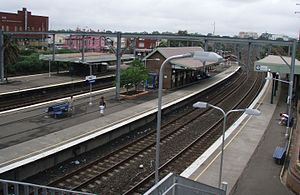
Homebush is a suburb in the Inner West of Sydney in the state of New South Wales, Australia. It is located 12 kilometres west of the Sydney central business district, in the local government area of the Municipality of Strathfield.

The Municipality of Strathfield is a local government area in the Inner West of Sydney, in the state of New South Wales, Australia.
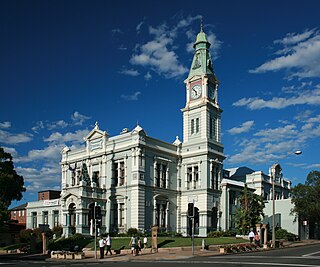
The Inner West of Sydney is an area directly west of the Sydney central business district, New South Wales, Australia. The suburbs that make up the Inner West are predominantly located along the southern shore of Port Jackson, stretching south to the shores of the Cooks River. The western boundary of the Inner West is approximately the A3 arterial road, which divides the Inner West from the Greater Western Sydney region. The Inner West is much larger than the Inner West Council local government area. The Inner West roughly corresponds with the Parish of Petersham and Parish of Concord, two cadastral divisions used for land titles.
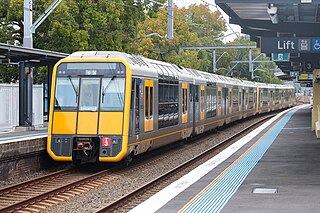
The Eastern Suburbs & Illawarra Line is a commuter railway line in the eastern and southern suburbs of Sydney and is a part of the Sydney Trains network. The line was constructed in the 1880s to Wollongong to take advantage of agricultural and mining potentials in the Illawarra area. In March 1926, it became the first railway in New South Wales to run electric train services.

The Australian state of New South Wales has an extensive network of railways, which were integral to the growth and development of the state. The vast majority of railway lines were government built and operated, but there were also several private railways, some of which operate to this day.
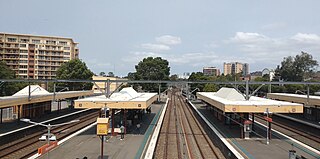
Homebush railway station is a heritage-listed railway station located on the Main Suburban line in Homebush in the Municipality of Strathfield local government area of New South Wales, Australia. It was designed and built by the New South Wales Government Railways and opened on 26 September 1855. In addition to being located on the Main Suburban line, the station is also located on the Main South and Main Western railway lines. The property was added to the New South Wales State Heritage Register on 2 April 1999.

The Main North Line is a major railway in New South Wales, Australia. It runs through Strathfield to Wallangarra. The line was the original main line between Sydney and Brisbane, however this required a change of gauge at Wallangarra. As of 1988, the line closed progressively north of Armidale with services gradually withdrawn till 2004, with the main route between Sydney and Brisbane now the North Coast line.

Strathfield railway station is a heritage-listed railway station located on the Main Suburban line in the Sydney suburb of Strathfield in the Municipality of Strathfield local government area of New South Wales, Australia. The station is served by Sydney Trains T1 North Shore & Western Line, T9 Northern Line and T2 Inner West & Leppington Line suburban services as well as NSW TrainLink Intercity and regional services. The station is located on the Main Northern and Main Western railway lines, forming a major junction for regional and suburban rail services. The station and associated infrastructure was added to the New South Wales State Heritage Register on 2 April 1999.

The Northern Line is a commuter rail line operated by Sydney Trains in Sydney, New South Wales, Australia. It serves some of Sydney's Inner West and Northern suburbs. It was spun off from the old T1 North Shore, Northern & Western Line as a separate line in April 2019, to distinguish and make it more easily identified from the other T1 services. It is also a reincarnation of the older Northern Line which was under operation until 2013.

The Bankstown Line is a commuter rail line operated by Sydney Trains in Sydney, New South Wales, Australia. It serves Canterbury-Bankstown and parts of the Inner West and Western Sydney. The Bankstown railway line is the physical railway line which carries the section of the Bankstown Line between Sydenham and Birrong.

Granville railway station is a train station located on the Main Suburban line, serving the suburb of Granville, New South Wales, Australia. It is served by Sydney Trains T1 Western Line and T2 Inner West & Leppington Line services. It is the junction for the Main Western line and the Main South line.

The Sydney Freight Network is a network of dedicated railway lines for freight in Sydney, Australia, linking the state's rural and interstate rail network with the city's main yard at Enfield and Port Botany. Its primary components are the Southern Sydney Freight Line (SSFL) and a line from Sefton to Enfield and Port Botany. The Network has been managed by the Australian Rail Track Corporation (ARTC) since 2012. Prior to the completion of the SSFL, it was managed by RailCorp as the Metropolitan Freight Network.

Sydney, the largest city in Australia, has an extensive network of passenger and freight railways. The passenger system includes an extensive suburban railway network, operated by Sydney Trains, a metro network and a light rail network. A dedicated freight network also exists. Future expansion of the light rail network includes the Parramatta Light Rail. Existing light rail services are the Inner West Light Rail and the CBD & South East Light Rail.
The Main Western Railway is a major railway in New South Wales, Australia. It runs through the Blue Mountains, Central West, North West Slopes and the Far West regions. It is 825 kilometres (513 mi) with 484 kilometres (301 mi) operational & 341 kilometres (212 mi) under construction & repairs.
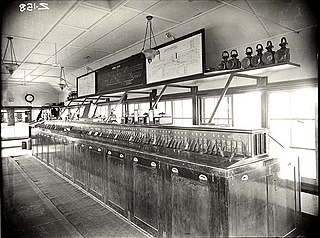
The Illawarra Junction is a major railway junction located near the Eveleigh Railway Workshops, in the inner western suburbs of Sydney, New South Wales, Australia. This complex junction joins a number of different lines and yards. There are two pairs of tracks from the Illawarra railway line from the south and three pairs of tracks from the Main Suburban railway line from the west.

The Ropes Creek Line is a closed railway line in the western suburbs of Sydney, Australia.

The Sydney Markets are a group of wholesale and retail markets in Sydney, New South Wales, Australia. The Sydney Markets are located in the Inner West suburb of Flemington, New South Wales, 16 kilometres west of the Sydney central business district. Flemington is in the local government area of the Municipality of Strathfield. The market is the primary distribution hub of fresh produce, flowers and other food products for Sydney. The market has a wholesale sales section that caters to larger businesses and general sales to the public. The market is the central marketplace for Sydney's farmers to sell their products. It has a history dating back to 1788. The operator of the markets is Sydney Markets Limited, formerly the Sydney Markets Authority, but privatised in 1997. As well as the markets at Flemington, Sydney Markets Limited also operates the inner city Paddy's Market in Haymarket.

The North Shore & Western Line is a commuter rail line operated by Sydney Trains in Sydney, New South Wales, Australia. It serves the North Shore, parts of the Inner West and Western Suburbs.

The Inner West & Leppington Line is a commuter rail service currently operated by Sydney Trains, serving the inner west and south-western regions of Sydney, Australia. Consisting of 37 stops, the service commences from the City Circle, then heads west to Granville. The line branches at this point; services either head northwest to Parramatta or south to Leppington. A third terminus at Homebush is used when the part-time Parramatta branch isn't operating. The line commenced operations on 26 November 2017, replacing the T2 Airport, Inner West & South Line.

The Olympic Park railway line is a railway line linking the Sydney Olympic Park precinct to the Main Suburban railway line at Flemington and Lidcombe. Originally opened as the Abattoirs branch in 1911, it was rebuilt and reopened as the Olympic Park railway line in 1998. Passenger services have since been running on it as the Olympic Park Line.

